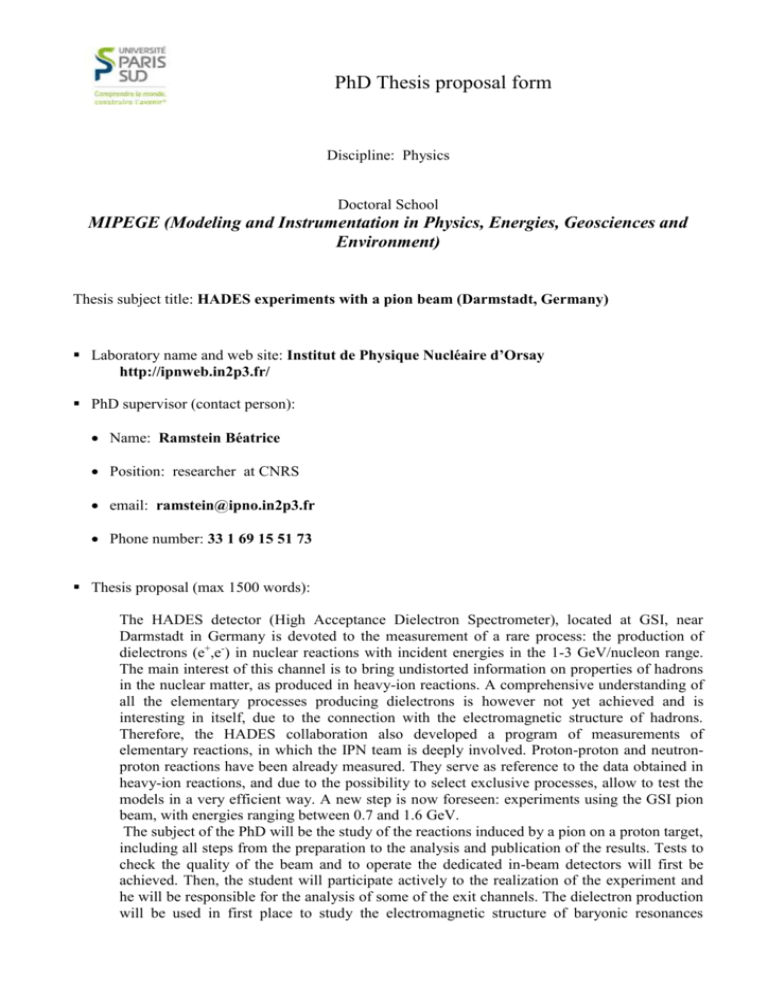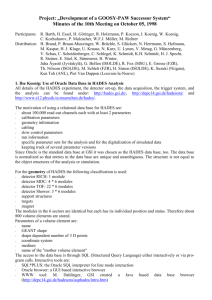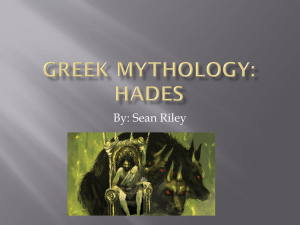Thesis
advertisement

PhD Thesis proposal form Discipline: Physics Doctoral School MIPEGE (Modeling and Instrumentation in Physics, Energies, Geosciences and Environment) Thesis subject title: HADES experiments with a pion beam (Darmstadt, Germany) Laboratory name and web site: Institut de Physique Nucléaire d’Orsay http://ipnweb.in2p3.fr/ PhD supervisor (contact person): Name: Ramstein Béatrice Position: researcher at CNRS email: ramstein@ipno.in2p3.fr Phone number: 33 1 69 15 51 73 Thesis proposal (max 1500 words): The HADES detector (High Acceptance Dielectron Spectrometer), located at GSI, near Darmstadt in Germany is devoted to the measurement of a rare process: the production of dielectrons (e+,e-) in nuclear reactions with incident energies in the 1-3 GeV/nucleon range. The main interest of this channel is to bring undistorted information on properties of hadrons in the nuclear matter, as produced in heavy-ion reactions. A comprehensive understanding of all the elementary processes producing dielectrons is however not yet achieved and is interesting in itself, due to the connection with the electromagnetic structure of hadrons. Therefore, the HADES collaboration also developed a program of measurements of elementary reactions, in which the IPN team is deeply involved. Proton-proton and neutronproton reactions have been already measured. They serve as reference to the data obtained in heavy-ion reactions, and due to the possibility to select exclusive processes, allow to test the models in a very efficient way. A new step is now foreseen: experiments using the GSI pion beam, with energies ranging between 0.7 and 1.6 GeV. The subject of the PhD will be the study of the reactions induced by a pion on a proton target, including all steps from the preparation to the analysis and publication of the results. Tests to check the quality of the beam and to operate the dedicated in-beam detectors will first be achieved. Then, the student will participate actively to the realization of the experiment and he will be responsible for the analysis of some of the exit channels. The dielectron production will be used in first place to study the electromagnetic structure of baryonic resonances (excited states of nucleons), in connection with the Heavy Ion HADES program. The twopion and eta meson production channels are also very interesting. They are connected to specific baryonic resonances and can solve open issues about the decay branching ratios or even the existence of these states. Publications of the laboratory in the field (max 5): "The High-Acceptance Dielectron Spectrometer HADES." G. Agakichiev et al. (HADES Collaboration ), Eur.Phys.J.A41 :243-277,2009. e-Print : arXiv :0902.3478 [nucl-ex]. "A versatile method for simulating pp ppe+e- and dp pne+e-pspec reactions", I. Fröhlich et al., EPJA45 :401-411,2010. "Origin of the low-mass electron pair excess in light nucleus-nucleus collisions.", G. Agakichiev et al. (HADES Collaboration), Phys.Lett.B690 :118-122,2010. "Study of dielectron production in C+C collisions at 1AGeV". G. Agakichiev et al., Phys.Lett. B 663 (2008) 43-48 «Exclusive measurements with the spectrometer HADES in proton-proton reactions at 1.25 GeV « Tingting Liu, PhD thesis, University Paris-Sud Specific requirements to apply, if any: A master degree in nuclear and particle physics is needed. The HADES collaboration brings 80 persons from different European countries together. We have a close collaboration with the Cracow (Poland) and GSI (Darmstadt, Germany) teams and we visit them frequently. Good practice of English (written and spoken), ability to work in different environments, communication skills and availability to travel are necessary.











